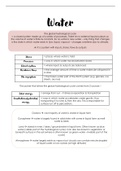Summary
Summary The water cycle and water insecurity revision notes for A Level Edexcel Geography
- Course
- Institution
An extremely detailed set of notes for the water cycle topic for A Level Edexcel Geography. I managed to achieve an A* in A Level Geography in 2022 using these notes as I included absolutely everything listed on the specification.
[Show more]



